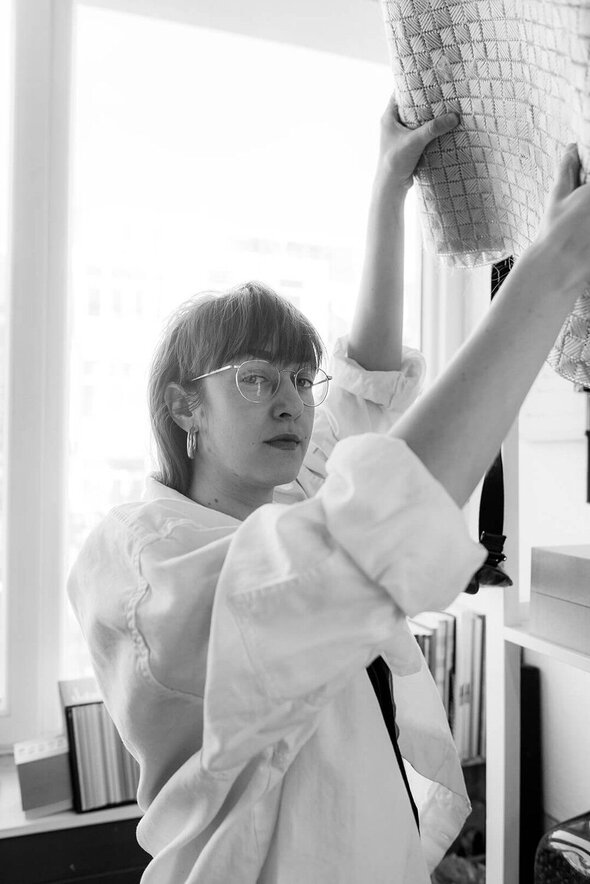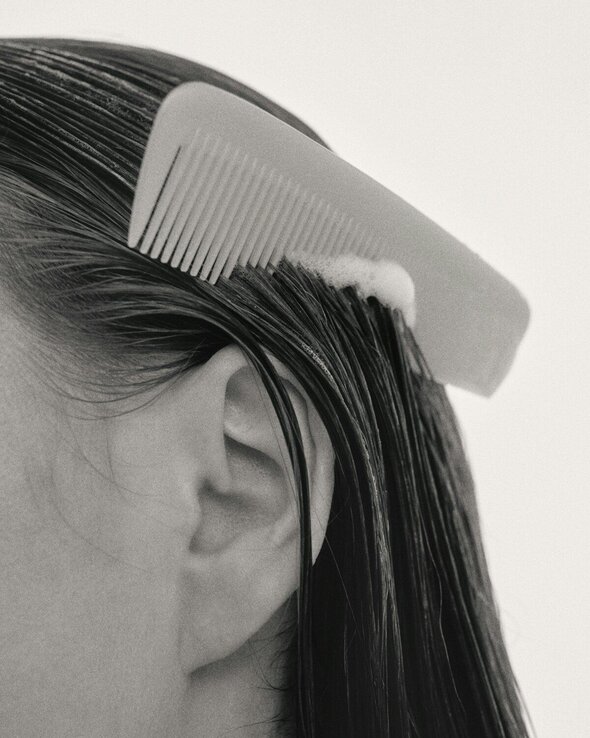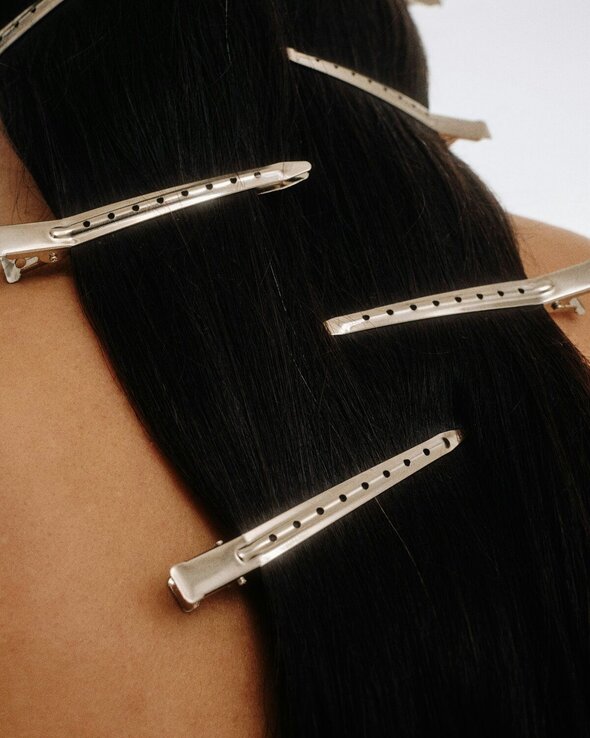Filter by: • All • Regulatory Compliance • Footprinting & LCA • AI & Technology • Retails Industry • Climate Science
When we first stumbled across the concept of Human Material Loop, the reaction across the team was a peculiar combination of bewilderment and curiosity all at once. Always energised by the prospect of discovering innovative developments within the industry; we thought we’d seen our fair share of unique raw materials. From grape skins to pineapple leaves, making use of waste from unusual sources was an idea we were used to. Yet the thought of using waste from humans had never crossed our minds.
For Zsofia Kollar however, this concept was a no-brainer. A fascination with hair and the time and money we invest into it, only to discard it without a thought once it’s cut, sparked an important question about value.
Why should hair lose all its value once it’s no longer attached to our heads? The answer: it shouldn’t.
Human Material Loop seeks to challenge the way we treat human hair waste; harnessing its natural properties to create a promising new textile resource. We sat down with Zsofia to find out more about how she plans to give circular fashion a fresh new look.
Words: Lydia Oyeniran
Interviewer: Annabel Lindsay
ANNABEL: Hi, Zsofia! Thank you so much for joining me today. When we came across Human Material Loop, it stopped our whole team in its tracks. It was just something we'd never heard of before - clothing made from human hair! We're really excited and intrigued to learn more about this innovative material and your work so let's dive headfirst into it.
Human hair for clothing is a very unique concept. I'd love to hear about the inspiration behind your organisation and the idea to create textiles from human hair.
ZSOFIA: Yes hi, thank you for having me! There are two folds into the whole story and to Human Material Loop. One started with the fascination of human hair, specifically how it loses all its value once it's cut.
While it's on our head, it's one of the most precious pieces we own, one of the most precious, most cherished pieces. We spend a lot of time, money, but once it's cut and it's on the floor in a hair salon, just neglected, it loses all its value.
“Hair is the same keratin protein fibre that all mammals and animals have on this planet. Why not just treat it in the same way we treat wool or goat hair or alpaca?”
ZSOFIA: The rabbit hole started to open and get deeper when I started to learn about the textile industry. Its exploitative and polluting practices. And then I was like, wow, okay, we can really give one solution to two problems here. That's how Human Material Loop was born; to really provide an innovative solution, turning hair waste into textile fibres.
The journey started and ever since, the team has been growing and we are defining the technology, the mission and all that along the way.
*******
ANNABEL: There's obviously a very big sustainability focus around what you're doing there, taking the value of something that's currently just classed as waste or discarded. So how do you source the hair from the salons that you work with?
ZSOFIA: We are sourcing the hair from hair salons. That was very important for us that we only want to source materials from places where we can really know that people cut their hair willingly. We could monitor that, but also know how we can create value for both parties - salons and us. So they can benefit from becoming zero waste, but also, what other products could they get in exchange to really make the hairdressers sort of the pillar of the circular economy.
ANNABEL: And what gives human hair an eco-edge over other fibres in the industry?
ZSOFIA: Well, it's quite a big difference. So if you consider human hair, we don't live to grow our hair. It's a byproduct of our lifestyle. So we don't have any cultivation emissions. We don't have any cultivation period. So just think about traditional crops; they need soil, pesticides, water, harvesting, all the machinery to process those fibres. We don't have that. So it's a big chunk of the emissions being cut off from the material.
But also if you compare it to the waste streams, for example, that are also processing it into fibres - we have one of the cleanest waste streams available out there. Just compare it to all other waste streams from the food industry or textiles. They still need to go through a washing process, but when we go to a hair salon, they wash our hair, and we wash it before, and you wash your hair most people once a week at least. So just the amount of steps that need to be taken for processing.
There’s also the availability. Think about how some materials are very concentrated in the world, so that has to be shipped all around. But human hair grows everywhere, so transport emissions can be cut off.
ANNABEL: I'm curious, you touched earlier on circular economy, which is obviously quite a buzzword in the industry. There's a lot of brands trying to move towards circularity. What's currently happening to the textiles that you produce? Is there an end of life process for the fibres? Can the hair be reused after life? Does it biodegrade?
ZSOFIA: The material is biodegradable. So within two years, it could break down in the right environment, just like wool, for example. Of course, we do see that the materials need to be in circulation above ground as long as possible to make the best use of them. So we are able to recycle our materials into new fibres again. We still need to do testing on how many times we are able to do that without losing the properties.
We are also developing three different technologies now to also ensure that we can keep the material completely in closed loop and circulation. So if one technology and one material could not be reused again, we can feed it into the other technology and then it remains in circulation in there. It was of key importance to develop the company and the technologies further; starting with a sustainability mission to make something better for everybody and really contribute to a better system globally.
So every step we are taking very seriously so that we do not cause any harm or waste.
ANNABEL: I really get the concept, especially from the sustainability and circularity standpoint, it absolutely makes sense what you're doing. But truthfully, when we first came across it, we were unsure about the idea. Someone wearing human hair was a new concept, but like you’ve said, we wear the hair of other animals so why is human different?
I guess i'm curious to know what the public response has been to the concept. Have you seen people be negative? Are people quite accepting of the idea?
ZSOFIA: Of course, we did quite a lot of surveys so we are aware of the fact that when we tell what we do, nobody is neutral. Everybody’s got a saying, everybody’s got an opinion. You cannot just be like “okay”.
We do think that's also one of our advantages, That it does not leave people indifferent when they are hearing it. And of course, when you hear it first, you are really shocked and it might feel a bit uncanny as well.
But if you think about it, most people come back to us after a few weeks and say "Zsofia, actually, it's quite logical."
"Most people come back to us after a few weeks and say: Zsofia, actually, it's quite logical.”
ZSOFIA: And I'm like, I know, I know! So people definitely need this digestion time to really get used to the idea. But also I think the main issue is that people can't imagine how these things look like and feel like. So even though we do think we have a big imagination, we realise that people will really need to have a tangible example to show what it is and how it is. And then they are way more receptive.
Of course, it's quite a radical idea to turn hair waste into a textile fibre. So it would definitely be the early adopters and the modern revolutionaries who are accepting it. Mainstream will follow later on. So we are absolutely aware that things will take some time and not everybody will feel comfortable with it at first.
We also see that maybe wearing it on your body is too far of a step ahead and maybe developing products for the interior and home like curtains or panels or carpets are way more easy to accept and get used to the idea.
On the other hand, if you look at the beauty and the hair trade industry, it's a booming business where people wear other people's hair already and nobody has an issue or disgust from it. You see these beautiful locks walking on the street in front of you, you are not like, oh that's other people's hair, attached to her hair. Nobody does that. So I think it’s just really, we just have to get used to the idea that material is material.
ANNABEL: Absolutely. And like you said earlier as well, we're already wearing the hair of other animals. So it's not really that much of a leap to be wearing the human hair that we grow ourselves. That lends itself really nicely into my next question.
Who do you envision being the ideal client? Do you see this being more for luxury markets, more of a niche, or do you see this being something adopted by the masses and by brands of all sizes?
ZSOFIA: We do have a big ambitious plan. We do want that most companies will adopt this material and use it. We do not want to have a niche market. We really want to capitalise on the market and make it as big as possible. Because it's really a material that is the healthiest to protect our own bodies and our environment. The smallest footprint you can imagine in the textile industry. So we really want that companies will adopt it.
We are a B2B company, so we are developing our materials for other businesses. We are very open to opportunities from other brands, companies, and designers to come test it and make a proposal.
What would they like to develop? How can they also ensure that their clients and their customers have a healthier material? And also to start talking about how textiles are very toxic. Most textiles on the market are toxic for our own health.
ANNABEL: Yeah, no, definitely. In terms of the adoption in the market so far then, aside from people getting on board with the concept in general, have there been any other barriers to bringing this to market and to working with other businesses?
ZSOFIA: We generally see quite big enthusiasm from the industry side. Of course, they are also very well aware that they need to change their current practices or make some steps ahead in the future. In general, we get really good feedback from the industry. Of course, there is hesitation on marketing, customer acceptance, and all that.
If people are fine wearing leather and other animal products on our skin, that are marketed as the highest luxury, I do believe that hair can also be just a regular material and can get over this fact.
“If people are fine wearing leather and other animal products on our skin, that are marketed as the highest luxury, I do believe that hair can also be just a regular material... ”
ZSOFIA: So far, we have quite a good response. Of course, there is some hesitation, but I think with every innovation, companies are testing the borders of the opportunities and the timing.
ANNABEL: Yeah, I think that's a really valid point as well. We're so used to leather, it’s such a normal concept, even though it's literally the skin of an animal. So hair has no victim per se. No one's had to die for it. So, yeah, it's a very, very good point there.
ANNABEL: So I'm guessing the use of keratin makes textiles that are quite durable, sturdy, and strong, is that right?
ZSOFIA: Right yeah absolutely! So we see that sustainability is not just about how and where we source materials, but also how long the products can last. Durability I think should also be one of the most important aspects of designing and producing anything.
ANNABEL: Absolutely. Completely agree with that and on the value of human waste, you mentioned earlier about perhaps working with interior brands and doing furnishings. Have you got plans as an organisation to expand beyond fashion? Do you see this being used in multiple industries?
ZSOFIA: Yeah, absolutely! Actually, I think we see the interior market as an even bigger industry than fashion for the early stages. We will have a big exhibition in Orgatec in Cologne in October. So if anybody is around and would like to visit, please pass by. You will see some more interior products from our side. Definitely, we are testing, we are a startup. We are also experimenting a lot. We are testing what products and segments can be the best fit. So we are very much in this agile experimental phase.
We also will soon launch an open call for young designers to propose what they would create from our material and actually make it happen as well. We see that we just need to also unleash this frustration within the design and fashion industry that people are struggling to create and design things because like, yeah, how can I design this? Like this material, you know, children picked this in the fields or animals were killed for this.
How could we keep it more positive and regenerative and really just focus on creativity and go wild with your ideas?
ANNABEL: What do you envision for the future of Human Material Loop textiles? How do you see the scalability of this material?
ZSOFIA: The future is really to scale up and put as much hair into production as possible and develop our technology further. That's really the goal. Now we are very much working on a European scale-up, and then after we achieve this, let's see which country and continent we will go to next. That's the plan, to be global and turn as much waste as possible into new materials.
ANNABEL: It all sounds unbelievably exciting. Thank you so much for sharing more about your incredible work and what you guys are doing. It's very inspiring and fills me with optimism that there are brands that are finding innovative solutions that have real world applications now, as we speak. We're really excited from our end to see what you guys do next and the progress you make. Thank you very much for sharing that all with us!
ZSOFIA: Yeah, you're very welcome!





